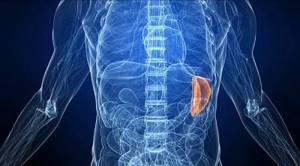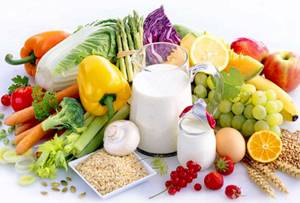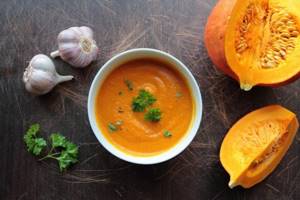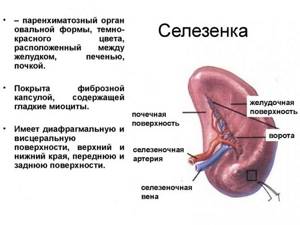Proper nutrition is very important for the optimal functioning of all organs and systems of our body, in particular the spleen. A certain diet allows you to quickly restore the functioning of the spleen after surgery and reduce the symptoms of certain diseases. If a person carefully compiles his menu, excluding various unhealthy dishes and snacks, then most diseases can be avoided altogether. Therefore, it is better to ask in advance which foods are good for the spleen.
Diagnostics
In addition to a personal examination and questioning of the patient, if this pathology is suspected, special laboratory and instrumental studies are carried out.
How is the disease determined:
- An ultrasound examination of the abdominal organs will accurately determine the possible enlargement and general condition of the spleen. In addition to conventional ultrasound, Doppler measurements of the vessels of the spleen are also performed to determine the speed of blood flow, thrombosed areas, spasm or vascular obstruction.
- Biochemical and clinical blood tests are also very informative. If the function of the spleen is impaired, the composition of the blood will change significantly, and anemic conditions will develop.
- Additional urine and stool tests will help determine underlying pathology, such as liver disease.
- MRI is also performed if a complete diagnosis is necessary.
The diagnosis is made based on the results of the examination; these pathologies are treated by a specialized doctor, depending on the problem detected (endocrinologist, hepatologist, gemologist, oncologist or others).
Video shows an enlarged spleen on ultrasound:
Compress of flour and semolina porridge
When a problem occurs with the abdominal organ, traditional therapy is often used. It cannot completely cure the disease; it is used only as an auxiliary method.
Compresses made from flour and semolina are used to eliminate excessive inflammation, swelling, and soreness. The product is applied to the left side of the abdomen.
The body is covered with cling film and allowed to soak. Leave for 20-30 minutes for the product to have an effect. A long course is needed, for 1-2 weeks.
Causes of enlarged spleen in adults and children
Despite the fact that the spleen is not a vital organ, its function in purifying and filtering blood is difficult to overestimate. In addition, the spleen participates in the formation of the immune system, in the exchange of iron in the blood, normalizes its composition and connection with red blood cells.
In normal condition, the weight of the spleen ranges from 50 to 250 grams, but with splenomegaly the increase can occur by one and a half times or more. This happens quite rarely, most often under the influence of negative factors (severe bacterial or viral infection), as well as concomitant diseases of internal organs.
The main reasons for an enlarged spleen:
- Cirrhosis and other severe liver diseases.
- Autoimmune diseases.
- Inflammatory processes occurring in acute or chronic form.
- Diseases of the circulatory system.
- Heart failure.
- Oncology.
- Specific infections (tuberculosis, syphilis, typhoid fever, HIV).
- Parasitic infestations.
Enlargement of the spleen occurs due to the accumulation and stagnation of blood in it, disruption of normal blood circulation, as well as in the presence of tumors, cysts, accumulation of lymphatic fluid or blockage by parasites.
In this case, the expanded capsule of the organ will put pressure on the surrounding tissues and nerve fibers. This in turn will lead to pain and discomfort in the left hypochondrium.
Instead of a foreword. The most mysterious organ
It turns out that there is an organ in our body about which we still know little, and its functions are not yet fully understood. This organ is the spleen. The mystery of the spleen has even formed the basis of several medical jokes. Thus, the famous philosopher M. Weber in one of his books cites a humorous saying taken from a lecture by a physiologist: “About the spleen, gentlemen, we know nothing. That’s all about the spleen!” Or here's another famous joke. A professor, taking an exam in medicine, asked a student to name the functions of this organ. The student replied: “Yesterday I knew them, but now everything has flown out of my head.” The professor exclaimed: “This is terrible! Finally, there was a person who knew at least something about the spleen, and he forgot everything!”
This, of course, is a joke, but, like every joke, there is a fairly significant grain of truth in it - the spleen is truly one of our most mysterious organs. It is generally accepted that a person without a spleen can live in peace - its removal is not a disaster for the body.
Scientists know that the spleen plays some role in the formation of blood during childhood and that it fights diseases of the blood and bone marrow, such as malaria and anemia. But here's what's interesting: if the spleen is removed from the body, these vital processes will still continue! It seems that other organs may take over the functions of the spleen, although this cannot be said with certainty.
So, the spleen can hardly be called a vital organ, and yet its significance cannot be denied - such a position would be, to put it mildly, irresponsible. Like any other organ in our body, the spleen has its own important functions, although not fully understood. She also has her own problems, which can have a very negative impact on the general condition of our body. This book is a comprehensive attempt to understand the most mysterious organ, because nothing in our body should be left unattended. And in our opinion, this is exactly the case when a little more knowledge about ourselves can only benefit us.
What foods are good for the spleen?
Strawberries are very good for the spleen
To prevent spleen problems, you should review your eating habits. First of all, you need to follow two simple rules:
- Avoid fast food, sweet soda, and snacks. Such products greatly undermine the functioning of the body. Let's say, if you treat yourself to chips or fries a couple of times a year, then the spleen and gastrointestinal tract will not experience much stress. But if you use any product from this list regularly (several times a month, for example), then you are seriously endangering your body and the spleen as a blood filter.
- Eat properly. It has long been known that the most useful nutrition plan is fractional. Portions should be small, and their quantity should be 5-6 per day. In the evening, it is better not to overeat, but to go to bed 3 hours after your last meal. This system will help maintain the proper functioning of the spleen throughout life.
In order to maintain the functioning of the organ, eat foods rich in iron every day. Here are some foods that are good for the spleen:
- pork, liver and other protein products (provided they are low-fat);
- buckwheat or millet porridge, cooked in a large amount of water (at least 1:4);
- canned or fresh legumes, tomatoes, broccoli, sauerkraut, garlic;
- fruits and berries: watermelons, black currants, strawberries, grapes;
- juices from fresh vegetables and fruits, prepared independently, without sugar (some juices should be diluted with water);
- fermented milk products, in particular, 0% fat cottage cheese;
- stale bread;
- For drinks, it is better to give preference to green tea (weak and freshly brewed), milk, and rosehip decoction.
Diet after surgery

Any greens in unlimited quantities are recommended after removal of the spleen
It should be understood that after the spleen is removed, other organs begin to perform its functions: the bone marrow takes over hematopoiesis, and the liver and lymphatic system receive an additional immune load. Taking this into account, nutrition after splenectomy should be aimed at:
- reduction of toxic effects on the liver;
- restoration of blood production;
- replenishment of resources necessary for the body (proteins and carbohydrates, copper and iron, vitamin C).
The diet after spleen removal is generally the same for both men and women. The only feature is the need to completely abstain from alcohol and tobacco products, and this point applies more to the stronger sex.
List of allowed products after surgery:
- vegetables and fruits in any form;
- any greens in unlimited quantities;
- all types of porridges (except pearl barley), initially in liquid form (in a ratio of 1:7);
- boiled poultry or low-fat fish;
- fermented milk products with low or zero fat content;
- vegetable and meat broths;
- a small amount of honey;
- teas, including herbal teas, coffee with milk, decoctions.
Creating a menu based on the listed products will be the most gentle for the liver and will allow the body to smoothly recover after surgery.
The best painkillers
Drugs called analgesics are designed to reduce the severity of pain.
The most effective painkillers contain the following active ingredients:
- Ibuprofen.
- Nimesulide.
- Ketorolac.
- Analgin.
- Paracetamol.
All analgesics are non-narcotic or narcotic in nature. The latter are used only as prescribed by a doctor.
The rating of the best painkillers is:
- Ketanov. The active ingredient is ketorolac. A powerful remedy. The result of its impact appears quickly, within forty minutes. To achieve a more effective analgesic effect, Ketanov is taken on an empty stomach. The duration of pain relief is up to six hours. Often a one-time dose is enough for minor ailments. The maximum daily dose is four times, the course is five days. Allowed for admission from the age of sixteen.
- Nurofen. A non-narcotic pain reliever based on the analgesic ibuprofen. It begins to act forty-five minutes after administration and provides pain relief for up to eight hours. The drug is convenient because it has a wide range of release forms: syrup, effervescent tablets, rectal suppositories, gel. It has antipyretic properties and acts quickly. The speed of action is comparable only with paracetamol, not much inferior to it. Nurofen is approved for treatment even in pediatrics and has few side effects.
- Nise. Has a powerful analgesic effect. But it has a short period of pain relief. The action begins half an hour after administration, and its concentration is maximum within three hours. The composition contains the active substance nimesulide. The medicine reduces the temperature. It is produced in the form of tablets, including soluble tablets, suspensions for use by children aged two years and older, and ointments.
- Novigan. Combination agent. The composition includes the analgesic ibuprofen in combination with the antispasmodic pitofenone. Thanks to this, it has a long-term pharmacological effect. Reduces the severity of an attack within twenty minutes after taking it. Available only in tablets, limited to the age of use - from 16 years.
- Pentalgin. Mixed medication. It contains drotaverine, paracetamol, caffeine, naproxen, pheniramine. This makes the medicine universal in its action. The patient receives analgesic, antipyretic, antispasmodic, and relaxing effects. Relief occurs within a period of ten to forty minutes. Contraindicated for children.
- Mig 400. Made from ibuprofen. The release form is tablets with a division exactly in the middle. The whole tablet is prescribed for a single dose for unbearable pain. For moderate painful manifestations, half is enough.
- Dexalgin. Strong painkiller. Suitable for postoperative, post-traumatic pain, cancer metastases. Analgesia is observed after half an hour and lasts up to six hours. Available in ampoules and tablets.
- Spasmalgon. One of the components of the medication is analgin (metamizole sodium).
- Analgin. Relieves spasms, reduces inflammation. It is easily absorbed, which ensures rapid pain relief - within the first twenty minutes. Side effects are minor and rare. It acts for a short time, which makes it suitable for mild pain. Can be used from the age of eight.
- Paracetamol. The antipyretic effect of the drug is much stronger than that of the anesthetic. Safe to use even in the field of obstetrics and pediatrics. Available in different forms. These are suppositories, syrup, capsules, solution for parenteral administration, powder for preparing a solution. Valid for up to six hours. Not approved for long-term use. Combination with salicylates increases the risk of urinary tract cancer.
In addition to non-narcotic drugs, there are also narcotic drugs. They are prescribed for use only by a doctor under conditions of severe unbearable pain. These drugs include Promedol, Tramadol.
Diet for the spleen
List of recommended products and dishes
Bread and bakery products:
- wheat bread crackers - 50 g per day.
- Rusks made from wholemeal flour will be very useful.
- mucous membranes from various cereals (oatmeal, rice, semolina, pearl barley, etc., except millet) in water or weak vegetable broth
- cream soup made from boiled meat
Meat and fish dishes:
- lean meat (beef, chicken, turkey, rabbit)
- free from fascia
- tendons and fat
- in the form of quenelles
- steam cutlets or soufflé
- Low-fat fish (pike perch, cod, carp, perch, etc.) in the form of soufflé
Milk, dairy products and dishes made from them:
- milk only in dishes
- fresh non-sour cottage cheese in paste form
- steam puddings
Egg dishes:
- soft-boiled egg (no more than 1-2 pieces per day)
- steam omelette
Vegetable dishes and side dishes:
- vegetables (potatoes, carrots, zucchini, cauliflower) in the form of puree
- steam puddings
butter, added to prepared dishes
Fruits, berries, sweets:
- butter, added to prepared dishes
- baked apples (except Antonov apples)
- pureed compotes from dry and fresh fruits
- jelly
- jelly
- xylitol mousses
- sorbitol
Stones in the pancreas (so-called
Pancreolithiasis is a very serious problem. And it cannot be ignored.
Because the pancreas plays an important role in digestion. Very often, stones form in the pancreatic duct.
In addition, it is very important to follow a diet. A special diet should include vegetable dishes, boiled fish, pasta and cereals
It is very important to limit your intake of eggs and fats. Food must be steamed
Regular nutrition is very important. It is very important to avoid overeating
One of the main points is the mandatory inclusion in the diet of foods containing large amounts of iron, which normalize hematopoiesis. These include:
- any types of fish, including fatty fish;
- all types of nuts;
- Bee Honey;
- white and cauliflower;
- beets;
- lemons, oranges, tangerines, grapefruits;
- grenades;
- avocado;
- apples and apple juices;
- cranberries
It is advisable to consume in smaller quantities:
- salt;
- butter;
- beef and veal meat;
- milk and ice cream.
All types of eating disorders, such as irregular eating, overeating or undereating, not only cause disturbances in the functioning of the spleen and pancreas as organs.
What is good for the spleen and pancreas?
The diet for the spleen is very similar in composition to the therapeutic dietary method for the liver, aimed at consuming iron-containing foods and dishes.
This dietary program is very effective, as it allows you to restore the functioning of a damaged organ and prevent possible diseases.
Diet after spleen removal
The diet after removal (splenectomy) consists of consuming a normal amount of proteins and carbohydrates, but limiting the consumption of refractory fats, foods containing cholesterol, and extractives. All dishes must be boiled or steamed, as eating fried food is strongly discouraged.
The daily energy value of the diet should be about 3000 kcal. It is recommended to exclude fresh bread from the diet; you can only eat bread that was baked yesterday.
Preference should be given to:
- Vegetable and milk soups with added cereals,
- Vegetable borscht,
- Lean meat
- Fatty fish
- Low-fat dairy products,
- Vegetables,
- Krupam.
Diet for inflammation of the spleen
The diet for inflammatory processes, like the previous one, is based on consuming large amounts of iron
It is very important that meals are frequent and regular. It is necessary to eat food at least 4-5 times a day
The main feature of therapeutic nutrition is the inclusion of foods high in iron in your diet to normalize hematopoiesis. These include:
- cauliflower and white cabbage;
- citrus;
- avocado and pomegranate;
- cranberries and apples;
- bee honey;
- fish of any kind (including fatty fish);
- beet;
- Apple juice;
- all varieties of nuts.
What is prohibited?
The following products are strictly prohibited for the pancreas, as well as for the liver:
- fried, spicy, peppery and fatty foods;
- fresh pastries and soft white bread;
- mushrooms, mushroom and meat broths;
- chocolate, products made from it;
- alcohol and carbonated drinks;
- herbs and spices;
- sorrel, radish, horseradish;
- canned meat and fish, lard, eggs.
If you have a sick spleen, remove this food from your diet forever, never include it even in the holiday menu, without making exceptions for anything. Drinking alcohol while dieting is especially harmful; it is a blow to the spleen. After this, exacerbations often occur, and the time spent on restoring the organ is wasted. Treatment usually needs to be started all over again.
Doctors' recommendations

To avoid stagnation in the spleen, you need to engage in sports and active leisure
In order for the spleen to function fully and perform its functions efficiently, it is not enough just to adhere to a diet for the spleen. You should also follow some recommendations from doctors. In general, they are common to the entire body and are known to most of us. So, be sure to:
Walk outdoors every day. If you live in a big city, then you should take walks, at least not near the road, but in a park or square. The ideal location is the sea coast and a coniferous forest. Review your response to stressful situations. Most unpleasant incidents in life do not deserve such a blow to the gastrointestinal tract and immunity. Choose clothes according to the season. Avoid hypothermia or overheating of the body. Get rid of tight clothes (this applies to those who like to wear corsets or specific underwear) - they interfere with normal blood flow. Avoid stagnant processes in the body, especially if you have a sedentary job. Move a lot, choose active leisure, play sports or exercise therapy. To improve blood flow and the functioning of the spleen, you can do self-massage of the abdomen. Make circular movements with your hand, just do not put strong pressure on the gastrointestinal tract and spleen. Make sure your diet includes foods rich in iron. Portions should be small
It is also important to combine dishes correctly; you should not eat the first, second and dessert at one time. For example, fish should not be eaten with bread or potatoes; it is better to choose a salad
You should also avoid eating several varieties of fruits and vegetables at one time. They will be difficult and long to digest due to the fact that each of them will require its own enzymes.
These comprehensive measures will help our largest “lymph node” always remain healthy.
In the abdominal cavity, in its upper left part, there is one of the important human organs - the spleen or splieen in English. It is located just below the diaphragm, slightly behind the stomach. Such close proximity sometimes makes it difficult to recognize the symptoms of spleen diseases, and the person thinks that he simply overate.
In ancient Greece, the organ was considered completely useless for humans; during the Middle Ages it was “blamed” for causing melancholy and gloomy thoughts. But it turns out that this unpaired organ performs the most important functions for humans: hematopoietic, filtration, immune.

The main work of the spleen is aimed at creating a supply of blood in the human body. It filters up to 250 ml of blood every minute, which allows you to cleanse it of pathogenic bacteria and increase clotting. The merit of the spleen is that it restores and “recycles” old and damaged blood cells, produces antibodies, and increases the body’s resistance to viral diseases. In case of blood loss, it replenishes the required amount of oxygenated blood with a large number of red blood cells and nutrients.
That is why every person should make sure that his spleen is completely healthy. Its normal functioning is facilitated by a healthy lifestyle: light physical activity, immune support in the form of vitamin complexes and immunomodulatory drugs and, of course, proper nutrition.
Preventive measures
The best prevention for maintaining organ health is maintaining a healthy lifestyle.
Basic measures aimed at maintaining the healthy state of the organ:
- Proper balanced nutrition. A person needs a whole complex of vitamins and minerals to maintain normal functioning of the body. Nuts, beef liver, carrots, beets, and fish dishes support the functioning of the spleen even with its pathologies.
- Sports activities. Regular physical exercise keeps a person in good shape and enhances natural protective functions.
- Refusal of alcoholic beverages, especially of dubious quality.
- Wear loose, non-constrictive clothing.
- Drinking plenty of water to cleanse the body in general and the spleen in particular.
- Regular visits to medical institutions for preventive examinations and blood tests.
It is important to avoid wounds and bruises in the abdominal area. If the torso is injured, carefully examine the area of injury. Start treatment of any diseases, including infectious diseases, in a timely manner. This will prevent the development of side complications in the form of disturbances in the functioning of internal organs.
Diet and prevention of spleen diseases
An integral part of complex treatment is dietary nutrition. It is necessary to follow certain nutritional rules:
- take food in small portions, but often;
- exclude very hot or cold foods and drinks;
- do not overeat;
- do not eat fatty, fried, spicy, salty foods, limit sweets;
- exclude difficult-to-digest foods.

If there is a need for surgical treatment and the patient undergoes a splenectomy, the body will continue to function normally. Colds may become more frequent due to the fact that due to the absence of the spleen, the main immune organ, immunoglobulins will no longer be produced.
And although if the spleen is removed, life will continue without catastrophic losses, you need to be more careful about your health. It is recommended to avoid dangerous situations that can lead to injury, follow a diet and give up bad habits, so as not to aggravate pancreatitis or gastritis and not suffer from painful discomfort not only in the pancreas, but also in the spleen.
Bibliography
- Maksimov, V. A. Clinical symptoms of acute and chronic pancreatitis. Handbook of a practicing physician 2010 No. 3 pp. 26–28.
- Poltyrev S.S., Kurtsin I.T. Physiology of digestion. M. Higher school. 1980
- Gastroenterology and hepatology: diagnosis and treatment. A guide for doctors, ed. A. V. Kalinina, A. I. Khazanova. M. Miklos, 2007
- Khrapam V.V., Valetsky V.L., Balaban O.V., Informativeness of methods for early laboratory diagnosis of acute pancreatitis. M.: GEOTAR-Media, 2006.
- Gabunia R.I., Kolesnikova E.K. Computed tomography in clinical diagnostics. - M. Medicine, 1995
- Todua F.I., Fedorov V.D., Kuzin M.I. Computed tomography of the abdominal organs. M. Medicine, 1991
- Trofimova E.Yu. Diagnostic punctures under ultrasound control 2001. Crimean Therapeutic Journal No. 2 pp. 109–115.
Source
How does nutrition affect her performance?
Proper nutrition can solve a large number of problems that, as it seems at first glance, should not depend on diet at all. Chinese medicine is especially famous for its research into the connection between nutrition and body health.
Overeating, cold or too hot, poorly prepared food, excess sweets and sugar lead to the fact that moisture begins to accumulate in the spleen, which develops into mucus.
Some even argue that all immune diseases, including such as lupus erythematosus or rheumatism, directly depend on the health of the spleen and the amount of this “mucus” in the body.
Is it possible to fast?
There are 3 main principles for treating the spleen, which, according to popular experts, can help. This is fasting, cold, peace. Therapeutic fasting is not recognized by official medicine, but it is believed that temporary refusal of food, and sometimes liquid, can cleanse and restore the digestive system. Therefore, the benefits that fasting brings are enormous; it can help the body get rid of “slagging”, which will improve a person’s health. Fasting has a special technique. You can use complete fasting, when it is possible for a person to drink liquid, and absolute fasting - “dry”. It is believed that fasting should not begin if the diet has not been followed, which is a kind of preparatory stage. For more effective treatment, fasting should be accompanied by bed rest. Such fasting will reduce the production of secretions, which will allow the spleen to rest.
Anti-inflammatory medications
Inflammatory processes in the spleen begin to develop when infectious agents penetrate it. The use of anti-inflammatory medications can eliminate pain, reduce temperature, and stop the development of inflammation.
Non-steroidal anti-inflammatory drugs have a number of negative effects, and therefore are prescribed to only some patients. These include: “Ketoprofen”, “Ketorol”, “Ketorolac” (help eliminate pain), “Amidoprine”, “Ibuprofen”, “Naproxen”, “Ketoprofen”, “Piroxicam”, “Diclofenac”, “Flurbiprofen”, “ Indomethacin" (allows you to eliminate the inflammatory reaction).
Steroid-type anti-inflammatory medications are essentially glucocorticoids synthesized by the adrenal cortex. They are characterized by a strong anti-inflammatory effect. Quite often they are recommended for the treatment of acute lymphoblastic and myeloblastic leukemia, infectious mononucleosis accompanied by splenomegaly. These include: Betamethasone, Triamcinolone, Methylprednisolone, Cortisone, Prednisolone, Dexamethasone, Hydrocortisone. These are the most popular drugs. Medicines for the treatment of the spleen must be prescribed by a doctor.
Spleen disease: symptoms and treatment methods and nutrition
In most cases, the presence of inflammatory processes in the organ can manifest itself with the following symptoms:
- loss of appetite;
- dizziness and loss of strength;
- gagging and nausea;
- skin color becomes gray;
- itchy sensations;
- the appearance of bitterness in the oral cavity;
- an increase in the size of the organ, which is noticeable when palpated;
- body temperature stays within 37.5-38°C;
- chills and anemia are present;
- the sclera of the eye becomes icteric;
- the presence in the organ of dull pain with regular acute attacks, in which antispasmodics have no effect.
Depending on what reasons could provoke the inflammation of the organ, the symptoms may change, since this is not an isolated phenomenon, and what the symptoms will be depends on which nearby organs the inflammation has spread to.
It should be noted that inflammatory processes of the lymphoid organ have several treatment methods, namely:
- medications, such as: Nux Vomita 3, Aconite 3 or Mercuris 3, Arsenica 3, and also Hina 3;
- proper nutrition and diet for an enlarged spleen;
- alternative medicine;
- surgical intervention.
Sudden onset of pain
Sharp, sudden pain in the place where the spleen is located may be a consequence of physical activity or indicate the development of the disease.
To relieve pain, simple steps are required:
- Lie on a flat surface with your arms and legs extended at your sides.
- Calm down, relax. A sedative may be taken.
- Establish even breathing.
If the condition does not improve, an ambulance is required. Self-medicating and leaving signals that have occurred without a medical examination is dangerous. You cannot heat or cool the sore spot. This may cause deterioration in health.
Healthy foods
In order for our spleen to “feel” well, it is worth changing some eating habits. First of all, give up fast food and Coca-Cola, which have a negative effect not only on tooth enamel, but also seriously undermine our health. You need to eat three times a day and have small snacks for yourself - after breakfast and towards dinner. Proper nutrition will help maintain the functioning of the spleen at the proper level.
To improve the condition of the body, it is recommended to use more foods rich in iron. They should be present in a person’s diet every day and can be consumed with virtually no restrictions. The basis for the menu for every day should be:
- Protein products: lean beef, pork, liver.
- Buckwheat or millet porridge cooked in water.
- Sauerkraut, fresh and canned green peas, beans, tomatoes, garlic, broccoli.
- Some types of berries and fruits: strawberries, grapes, watermelon, black currants.
- Freshly prepared vegetable and fruit and berry juices.
- All types of fermented milk products, especially low-fat cottage cheese.
- From drinks you can choose weakly brewed tea, coffee drink with chicory, milk, rosehip decoction.
- Slightly stale bread.
But the following foods are especially beneficial for the spleen:

- Any nuts. The minerals and trace elements they contain activate the hematopoietic function of the organ.
- White cabbage and cauliflower. The vitamin K it contains has a beneficial effect on blood clotting, folic acid promotes the synthesis of new blood cells, and vitamin P helps strengthen the walls of blood vessels.
- Beet. It stimulates the activity of the spleen, promotes the production of more blood, and strengthens the walls of blood vessels. It’s not for nothing that it’s called a natural hematopoietic. It is useful to prepare dishes in combination with cabbage, tomatoes or carrots.
- Fatty fish, preferably sea fish. It contains a lot of Omega fatty acids and taurine, which normalize blood pressure.
- Liver. This is a source of iron, a small amount of which in the blood can lead to anemia. Heparin contained in the liver serves to prevent thrombosis and myocardial infarction.
- Honey. It helps normalize the function of the spleen associated with the production of blood enzymes.
- Citrus. The vitamin C they contain promotes the body's absorption of iron, vitamin A, organic acids and fiber. As a result of regular use of citrus fruits, cholesterol and sugar levels in the blood decrease.
- Apples. They contain pectin, which regulates sugar levels.
- Avocado. The fruit is able to bind excess cholesterol, which can clog the hematopoietic channels of the spleen.
- Pomegranate. Helps produce more blood.
It will also be useful to know that:
- Apple and carrot juice cleanse the blood well and help the spleen to always be in good shape.
- Cranberry juice not only cleanses the oral cavity well, but also prevents the development of tumors in the hematopoietic organ.
Dish recipes
To ensure that a diet for an enlarged liver is not only beneficial, but also enjoyable, it is recommended to diversify the diet with dishes prepared according to unusual recipes.
Pumpkin soup
Required components:
- Pumpkin – 0.5 kg;
- Milk – 650 ml;
- Wheat bread – 150 gr;
- Butter – 25 g;
- Salt - to taste.

The vegetable is peeled and freed from seeds. After this, the product is poured with part of the boiling milk so as to completely cover the pumpkin, and set to cook. Add bread to the dish and leave the soup on the fire until the ingredients are completely boiled. Next, the components are crushed in a blender, the remaining boiling milk is added and salt is added. The soup is left to cook for another 15 minutes, after which butter is added and served.
Lenten cabbage soup
To prepare the dish you need:
- Cabbage – 150 gr;
- Potatoes – 150 gr;
- Carrots – 50 gr;
- Tomato – 1 pc.;
- Vegetable oil – 1 large spoon;
- Salt - to taste.
The tomato is peeled and grated on a coarse grater. Peel the carrots and grate them into a fine grater. Both vegetables are combined and simmered for 5 minutes. Add shredded cabbage and chopped potatoes to boiling salted water. 5 minutes before readiness, add stewed vegetables to the soup. The dish is served with sour cream.
Rice casserole with vegetables
Required Products:
- Zucchini – 250 gr;
- Rice – 1 glass;
- Carrots – 1 pc.;
- Butter – 25 g;
- Salt - to taste.
The zucchini is peeled, cut crosswise into 2 parts and freed from seeds without violating the integrity. The vegetable is cut into rings and boiled in salted water for 15 minutes. Boil the rice until tender. The carrots are peeled and grated into a fine grater. The vegetable is mixed with butter and simmered for 5 minutes. After this, the carrots are mixed with rice and rubbed with a wooden pestle. Grease a baking sheet with vegetable oil and lay out the zucchini. After this, add rice and carrots and simmer until done.
Beef pilaf
Required components:
- Beef – 200 gr;
- Rice – 1 glass;
- Carrots – 1 pc.;
- Water – 160 ml;
- Butter – 10 g;
- Salt - to taste.
The meat is cut into cubes and boiled until cooked. Peel the carrots, grate them into a fine grater, add butter and simmer for five minutes. The vegetable is combined with beef. The rice is washed and added to the prepared foods. Add the specified amount of water, salt and simmer until done.
Corn balls
To prepare this dish, you will need the following ingredients:
- Corn grits – 1 cup;
- Chicken egg whites – 2 pcs.;
- Breadcrumbs - 2 large spoons.
Boil the cereal until tender. After this, wait until the porridge cools down. Beat the whites until foam appears and mix with the porridge. Cutlets are made from the resulting mass and rolled in breadcrumbs. The meatballs are placed in a double boiler and left until cooked.
Apple parfait
To prepare the dish you need:
- Apples – 3 pcs.;
- Chicken proteins – 2 pcs.;
- Butter – 25 g;
- Sugar – 1 large spoon.
The apples are washed, peeled, cut, cored and cut into small pieces. After this, the pieces of fruit are placed on a baking sheet greased with butter and placed in the oven to bake. Oven temperature – 1800C. The apples are baked until they are soft. This takes about a quarter of an hour. The apples are crushed to a puree using a blender and mixed with sugar. Beat the whites until a stable foam forms. Whisk all the ingredients, distribute into molds and place in a double boiler for 10 minutes.
Egg white sponge cake
Required components:
- Proteins – 6 pcs.;
- Sugar – 1/3 cup;
- Crushed wheat bread crackers – 1 cup;
- Culinary poppy seeds – 2 large spoons;
- Butter – 10 gr.
Grease a baking tray with butter. Beat the whites together with sugar until a stable foam forms. After this, the mass is mixed with breadcrumbs. Pour half the mixture onto a baking sheet. Place poppy seeds on top and spread the rest of the mixture. The biscuit is placed in an oven heated to 1800C. Bake the dish for 30 minutes.

A diet for liver hepatomegaly is a prerequisite for restoring the organ and its functions. Proper nutrition also guarantees the effectiveness of the therapeutic measures.
2018 – 2021, MedPechen.ru. All rights reserved.
Source
What does dull, pulling or cutting pain in the spleen indicate?
Pain in the spleen area can be severe, sharp, sharp, aching, and pulling. It all depends on the cause of its occurrence. And there are many of them. The spleen can hurt both on its own and due to the impact of diseases of other organs on it. This is how syphilis, echinococcosis, and tuberculosis spread.
Only a doctor can make an accurate diagnosis of the changes occurring in the body.
Possible organ damage:
- Closed type damage. Caused by injuries received after a blow or fall. Accompanying symptoms include pale skin, cold sweat, feeling of weakness, thirst, nausea, vomiting, and low blood pressure. The pain is sharp, concentrated in the left side. Gives to the area of the shoulder blade. The condition improves when sitting. The appearance of hematomas is noticeable on the outside.
- Open organ damage. Caused by wounds in the chest area on the left. There is an acute feeling of pain in the affected area and profuse bleeding.
- Abscess. The development of an acute inflammatory process occurs against the background of an increase in body temperature, chills, nausea, dizziness, and an increase in the volume of the spleen. The source of pain is located in the hypochondrium, spreading in waves towards the shoulder and chest area. The accumulation of pus provokes fever. The cause of the abscess is endocarditis, hemoglobinopathy, and infection.
- Tuberculosis. It is provoked by a similar lung disease. Unbearable, unbearable pain, enlargement of the organ to enormous sizes. At the initial stage, the disease does not manifest itself.
- Heart attack. The symptoms manifested are similar to cardiac rupture. The pain is localized in the left hypochondrium and radiates to the lumbar region of the back. The attack intensifies when inhaling. An extensive heart attack is manifested by unbearable sensations.
- Tumor. Any type of this disease is characterized by a visible increase in the affected object, a constant, incessant sensation of dull aching pain in the back on the left under the rib. The patient experiences a low but persistent increase in temperature, decreased activity, and loss of appetite. The disease occurs more often in women.
- "Wandering spleen" syndrome. It appears to a greater extent in women. This is due to the weakness of the anatomical ligament of organs in the female body. Accompanied by an acute attack in the abdomen.
- Cyst. Constant discomfort behind the stomach. The very first sign of formation is urticaria. Itchy skin is combined with fever, fatigue, and decreased appetite.
Painful sensations in the spleen, echoing into the liver, become a signal of the development of cirrhosis. The organ also hurts with the development of dangerous diseases: syphilis, typhoid, malaria, mononucleosis.
When do you need to go to the hospital, which specialist will help?
Pathological changes in the spleen are reflected by severe pain behind the stomach, in the left hypochondrium. An unpleasant sensation may spread to the scapula area. Such symptoms occur due to rupture of the spleen, cracks and wounds on it.
Hemorrhage occurs in the peritoneum, it is accompanied by:
- nausea;
- vomiting;
- trembling of limbs;
- pale skin;
- difficulty breathing.
An increase in the size of the spleen is no less dangerous. This can be suggested by the appearance of a protruding seal on the left side.
Additional symptoms are:
- pallor of the skin, which becomes especially noticeable on the face;
- increasing pain in the left hypochondrium with movement or muscle tension;
- discomfort in the navel;
- increased fatigue;
- decreased immunity;
- decreased hemoglobin levels;
- increased heart rate;
- heaviness in the stomach;
- frequently recurring bleeding;
- heat;
- the occurrence of ulcers in the mouth, on the extremities;
- damage to the lymph nodes.
If there are signs of a violation of the integrity of an organ or a change in its size, timely consultation with a doctor is required.
For pain in the spleen, an initial examination by a physician is required. He will palpate the organ and send you for an ultrasound examination.

Depending on the identified picture of the disease, doctors will continue further treatment:
- gastroenterologist;
- hematologist;
- surgeon;
- oncologist.
Surgical intervention to remove an organ is carried out when its condition is advanced. In other cases, drug therapy is prescribed.










